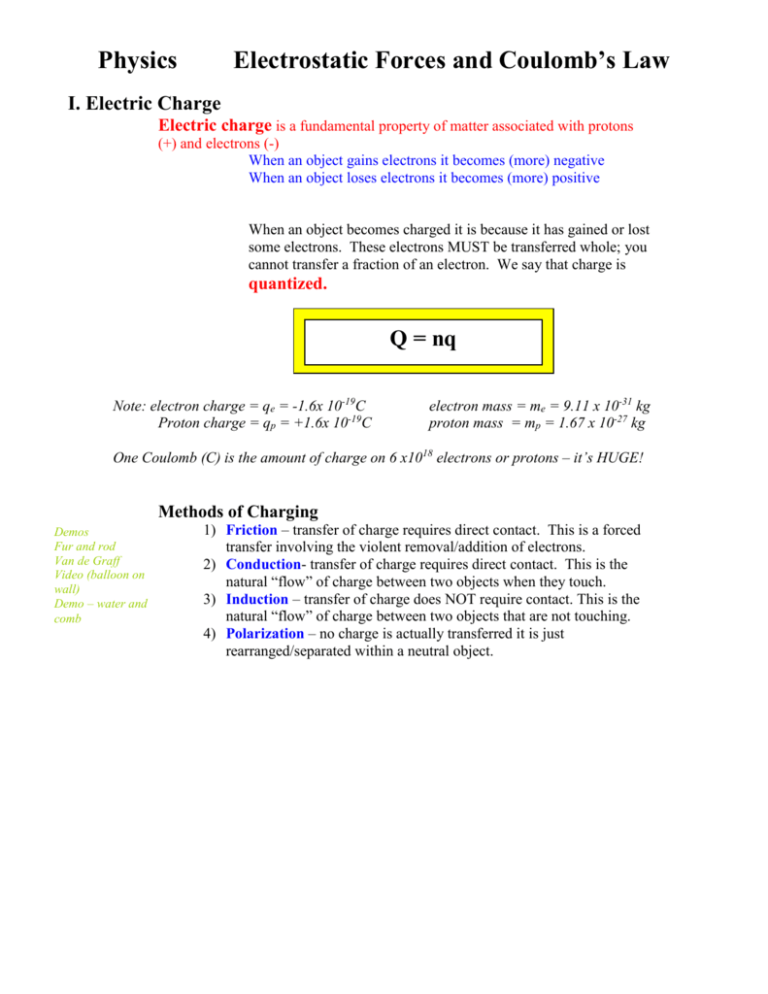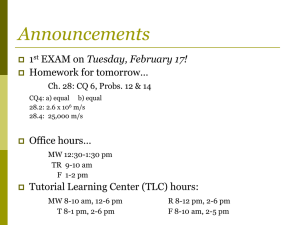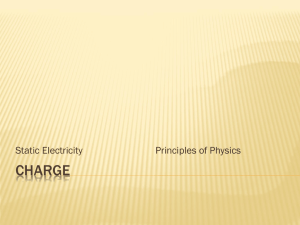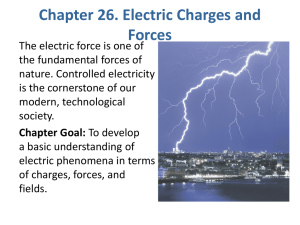Physics
advertisement

Electrostatic Forces and Coulomb’s Law Physics I. Electric Charge Electric charge is a fundamental property of matter associated with protons (+) and electrons (-) When an object gains electrons it becomes (more) negative When an object loses electrons it becomes (more) positive When an object becomes charged it is because it has gained or lost some electrons. These electrons MUST be transferred whole; you cannot transfer a fraction of an electron. We say that charge is quantized. Q = nq Note: electron charge = qe = -1.6x 10-19C Proton charge = qp = +1.6x 10-19C electron mass = me = 9.11 x 10-31 kg proton mass = mp = 1.67 x 10-27 kg One Coulomb (C) is the amount of charge on 6 x1018 electrons or protons – it’s HUGE! Methods of Charging Demos Fur and rod Van de Graff Video (balloon on wall) Demo – water and comb 1) Friction – transfer of charge requires direct contact. This is a forced transfer involving the violent removal/addition of electrons. 2) Conduction- transfer of charge requires direct contact. This is the natural “flow” of charge between two objects when they touch. 3) Induction – transfer of charge does NOT require contact. This is the natural “flow” of charge between two objects that are not touching. 4) Polarization – no charge is actually transferred it is just rearranged/separated within a neutral object. Charge-Force Law (a.k.a. Law of Charges): Similar charges will repel each other while opposite charges attract. You will use this law to determine the DIRECTION of a force on a given charged particle. Video Balloons on strings For example in the picture below two electrons are placed near one another. The direction of the force on electron A is to the left because it is being repelled by electron B. The direction of the force on electron B is to the right because it is being repelled by electron A. neg neg A B For example in the picture below a proton and electron are placed near one another. The direction of the force on charge A is to the right because it is attracted to charge B. The direction of the force on charge B is to the left because it is attracted to charge A. pos neg A B Conservation of Charge: the net charge on an isolated system remains constant. Example: A system consists of two charged metal spheres. Sphere A has a charge of 20μC and sphere B has a charge of 10μC. If the charges are brought into contact with each other, what is the resulting charge on each sphere? Example: A system consists of two charged metal spheres. Sphere A has a charge of 20μC and sphere B has a charge of -10μC. If the charges are brought into contact with each other, what is the resulting charge on each sphere? Homework 1 Electric Charge 1) An object becomes charged. If the net charge on the object is 20μC determine: a) if the object gained or lost electrons to become charged. b) how many electrons were gained or lost. c) the mass of the electrons that were transferred. 2) If 200mg of electrons are transferred onto a balloon determine: a) how many electrons were transferred. b) the resulting charge on the balloon. 3) Two objects are initially charged to qA = -10μC and qB = 7μC. If the objects are allowed to touch, what is the resulting charge on each object? II. Coulomb’s Law Coulomb’s Law allows us to determine the (electric) force between two charged particles. The magnitude of the force with which charges attract or repel is given by Coulomb’s Law. The direction of this force is given by the charge force law. Coulomb’s Law – there is a mutual force (of attraction or repulsion) between ANY two charges which is directly proportional to the product of the charges and inversely proportional to the distance* between the charges squared. *The distance is the center-to-center distance F kq1 q 2 r2 where k is the constant of proportionality (Coulomb’s constant) k = 9.0 x 109 Nm 2 C2 NOTES: According to Newton’s 3rd law the forces are equal (in magnitude) and opposite (in direction) DO NOT use the sign of the charge in the calculation If there are more than two charges, you can only analyze the force between two of them at a time. You would then combine all of the forces (for each pair of charges) using your rules for vectors. You may have noticed that this is very similar (in concept) to Newton’s Universal Law of Gravitation Newton’s Law of Gravitation There is a mutual force of attraction between ANY two masses which is directly proportional to the product of the masses and inversely proportional to the distance between their centers squared. F Gm1m2 r2 The gravitational force is a field force meaning it can act without direct contact. Coulomb’s Law of Electrostatic Forces There is a mutual force (of attraction or repulsion) between ANY two charges which is directly proportional to the product of the charges and inversely proportional to the distance between their centers squared. F kq1 q 2 r2 The electrostatic force is a field force meaning it can act without direct contact. Example: A small piece of plastic has a charge of +6.0μC. It is placed 12.0-cm away from another piece of plastic which carries a charge of -4.0μC. a) What is the electric force between the plastics? b) Did the first piece of plastic gain or lose electrons to become charged? How many electrons did it gain or lose? c) How much mass did the first piece of plastic gain/lose as a result of the transfer of electrons? Example: For the collection of charges shown below, what is the NET force on charge 2? Let q1 = 5μC, q2 = 10μC and q3 = -15μC q1 q2 q3 Example: Consider the charges shown below. Assuming that they are fixed in position determine: q1 q2 a) Where (w/r/t charge 1) could an electron be placed in order to have it in static equilibrium? b) If you place a proton in the system rather than an electron, where (w/r/t charge 1) should it be placed to be in static equilibrium? III. Electric Field (E) Field (E) is NOT the same as Force (F) BUT Field (E) is related to Force (F) Think about Gravitational Forces and Fields… Electric Fields (E) We know that two masses will exert equal and opposite forces on each other. So an We know that two charges will exert equal and opposite forces on each other. apple near the surface of the earth exerts a force on the earth and the earth exerts an equal/opposite force on the apple. So an electron placed near a proton will exert a force on the proton and the proton exerts an equal/opposite force on the electron. Any object near the Earth (or any other object will mass) will experience a gravitational force due to the Earth’s Gravitational Field. This field is an indication of the RELATIVE strength/magnitude of the force that exists between it (Earth) and another mass. You can think of the field as the physical effect of a mass on the space surrounding it. Field is due to a single mass whereas Force is due to a pair of masses. A gravitational field is created by any one mass, however, a second mass will experience a force when placed in this field. ANY object (charged) placed near a source charge (Q) will experience a force due to the electric field. The field (E) exists due to a source charge Demo – Van de Graff A charge placed in this field will experience a force Demo – ball and Van de Graff You cannot detect the field until another (test) charge is placed in it, although the field exists without the second charge. Electric Field (E) is the ratio of the force on a test charge to the magnitude of the charge itself. E F q E kQ r2 IV. Electric field Lines Electric Field Lines are a graphical way to visualize an electric field. Based on how a proton (or other positive charge) would react when placed in the field. The Rules: 1) Field lines are drawn away from positive charges and toward negative charges. 2) The closer together the field lines, the stronger the field. 3) The number of field lines indicates the relative charge. Example: An electric field of 260,000N/C points due west. What are the magnitude and direction of the force on a proton at this location? b) What are the magnitude and direction of the force on an electron? Example: Draw the electric field lines around an isolated positive charge. Draw the electric field lines around an isolated system made up of one electron and one proton. Draw the electric field lines around an isolated system made up of two protons. Example 3 Two charges are arranged as shown. a) What is the electric field due to the positive charge at point P? +6μC -9μC P 25.0cm b) What is the net electric field due at point P? c) Where would the net field be zero? Special Information Electric Field and Conductors Insulators Conductors Semiconductors Superconductors For a static, isolated system: 1) Any excess charge placed on an isolated conductor resides entirely on the surface of the conductor. This is due to electrostatic repulsion. 2) The (net) electric field inside a charged conductor is ZERO. Faraday Cage 3) The electric field at any one point at the surface of the conductor is perpendicular to the surface. 4) Excess charge tends to accumulate at sharp points on charged conductors.








